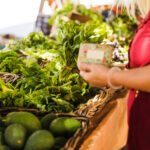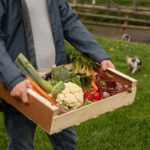Farming has come a long way from its traditional roots, and while many of us still think of it as working the land with plows and hands, modern innovations are reshaping the future of agriculture. From tech-driven farming practices to sustainable solutions that protect the environment, the future of farming looks both exciting and transformative. Let’s explore how innovation and sustainability are paving the way for a new era of farming.
1. Tech Meets Tradition: The Rise of Smart Farming
Smart farming, or precision agriculture, is a growing trend that combines modern technology with traditional farming practices. This tech-driven approach uses data, sensors, and artificial intelligence (AI) to help farmers make informed decisions about planting, watering, fertilizing, and harvesting crops.
-
Drones are used to monitor crop health, assess soil conditions, and even distribute fertilizers or pesticides efficiently.
-
Soil sensors measure moisture levels and nutrient content, helping farmers optimize irrigation and reduce water waste.
-
AI-driven analytics allow farmers to predict the best times to plant and harvest based on weather patterns and soil conditions, maximizing yield while minimizing waste.
These tools not only improve efficiency but also reduce the environmental footprint of farming, making agriculture more sustainable in the long run.
2. Vertical Farming: Growing Up, Not Out
As urban areas grow, space for traditional farming becomes increasingly limited. Enter vertical farming — an innovative solution that allows crops to grow in stacked layers or vertically inclined surfaces, typically in indoor environments. This method uses less land and can be combined with hydroponics (growing plants in water rather than soil) to save even more resources.
Benefits of vertical farming include:
-
Efficient land use: Farms can be set up in cities or on rooftops, reducing the need for long transportation routes.
-
Reduced water usage: Many vertical farming systems use hydroponics, requiring far less water than traditional soil-based farming.
-
Local food production: With vertical farms located in urban areas, food can be grown closer to where it’s consumed, reducing the carbon footprint of transportation.
Vertical farming is still in its early stages but has enormous potential to revolutionize food production in densely populated areas.
3. Regenerative Farming: Healing the Earth
Regenerative farming focuses on improving soil health and biodiversity by using farming practices that regenerate, rather than deplete, the land. Unlike conventional farming, which often relies on synthetic fertilizers and pesticides, regenerative farming emphasizes holistic, natural methods that restore the ecosystem.
Some key practices include:
-
Crop rotation and intercropping to prevent soil depletion.
-
Cover crops that enrich the soil with nutrients and reduce erosion.
-
Agroforestry, which integrates trees into farmland to improve biodiversity and water retention.
Regenerative farming not only benefits the land but also has a positive impact on the climate, as healthy soils can sequester more carbon, helping to mitigate climate change.
4. Sustainable Packaging and Waste Reduction
The future of farming is not just about how food is grown but also how it’s packaged and distributed. As consumer awareness about waste grows, more farmers are adopting sustainable packaging options to reduce plastic use and environmental impact.
-
Biodegradable packaging made from plant-based materials is replacing plastic in many food products.
-
Composting is being encouraged to turn organic waste into nutrient-rich soil.
-
Zero-waste initiatives at farmers’ markets and food co-ops are helping reduce food waste by allowing customers to bring their own containers or buy in bulk.
By adopting these practices, farmers can reduce the environmental impact of their food production and packaging, contributing to a more sustainable food system.
5. Consumer Power: The Shift Towards Conscious Eating
Consumers have a huge role to play in the future of farming. With the rise of sustainable, eco-friendly products, more people are becoming conscious of where their food comes from and how it’s produced. This shift is driving farmers to adopt more sustainable practices and produce food that aligns with ethical and environmental values.
-
Farm-to-table dining is gaining popularity, where food is sourced directly from local farms, reducing food miles and ensuring freshness.
-
Plant-based eating is growing, with more people turning to plant-based alternatives to reduce their environmental footprint.
-
Transparency is key — consumers want to know how their food is grown, harvested, and packaged, which is pushing brands and farmers to be more open about their practices.
By supporting ethical, local, and sustainable farming practices, consumers are helping shape the future of agriculture.
6. The Role of Government and Policy
Government policy is crucial in driving the transition to sustainable farming. Regulations that promote eco-friendly practices, support small-scale farmers, and incentivize sustainable agriculture can make a huge difference. Programs like subsidies for organic farming, tax incentives for green technologies, and investment in rural infrastructure are all part of the equation.
Farmers are not alone in their journey toward sustainability — policy makers, consumers, and businesses must all collaborate to create a sustainable future for agriculture.
Final Thoughts
The future of farming is bright, with technology and sustainability working hand in hand to create a food system that’s not only efficient and innovative but also environmentally conscious. As consumers, we can support these changes by choosing products that align with our values and advocating for policies that support sustainable farming. Together, we can help build a future where farming nourishes both the planet and its people.








